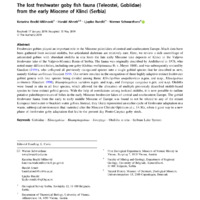The lost freshwater goby fish fauna (Teleostei, Gobiidae) from the early Miocene of Klinci (Serbia)
Објеката
- Тип
- Рад у часопису
- Верзија рада
- објављена верзија
- Језик
- енглески
- Креатор
- Katarina Bradić-Milinović, Harald Ahnelt, Ljupko Rundić, Werner Schwarzhans
- Извор
- Swiss Journal of Palaeontology
- Издавач
- Springer Science and Business Media LLC
- Датум издавања
- 2019
- Сажетак
- Freshwater gobies played an important role in the Miocene paleolakes of central and southeastern Europe. Much data have been gathered from isolated otoliths, but articulated skeletons are relatively rare. Here, we review a rich assemblage of articulated gobies with abundant otoliths in situ from the late early Miocene lake deposits of Klinci in the Valjevo freshwater lake of the Valjevo-Mionica Basin of Serbia. The fauna was originally described by Anđelković in 1978, who noted many different fishes, including one goby (Gobius multipinnatus H. v. Meyer 1848), and was subsequently revised by Gaudant (1998), who collapsed all previously recognized species into a single gobiid species that he described as new, namely Gobius serbiensis Gaudant 1998. Our review resulted in the recognition of three highly adaptive extinct freshwater gobiid genera with four species being divided among them: Klincigobius andjelkovicae n.gen. and n.sp., Klincigobius serbiensis (Gaudant 1998), Rhamphogobius varidens n.gen. and n.sp., and Toxopyge campylus n.gen. and n.sp. Otoliths were found in situ in all four species, which allowed for the allocation of multiple previously described otolith-based species to these extinct gobiid genera. With the help of correlations among isolated otoliths, it is now possible to outline putative paleobioprovinces of fishes in the early Miocene freshwater lakes of central and southeastern Europe. The gobiid freshwater fauna from the early to early middle Miocene of Europe was found to not be related to any of the extant European freshwater or brackish water gobies. Instead, they likely represented an earlier cycle of freshwater adaptation in a warm, subtropical environment that vanished after the Miocene Climate Optimum at c. 14 Ma, when it gave way to a new phase of freshwater goby adaptation that led to the present day Ponto-Caspian goby stock.
- том
- 138
- Број
- 2
- почетак странице
- 285
- крај странице
- 315
- doi
- 10.1007/s13358-019-00194-4
- issn
- 1664-2376
- Subject
- Gobiidae, Klincigobius, Rhamphogobius, Toxopyge, Otoliti in situ, Srpski jezerski sistem
- Gobiidae, Klincigobius, Rhamphogobius, Toxopyge, Otoliths in situ, Serbian Lake System
- Шира категорија рада
- M20
- Ужа категорија рада
- М23
- Права
- Отворени приступ
- Лиценца
- Creative Commons – Attribution 4.0 International
- Формат
Katarina Bradić-Milinović, Harald Ahnelt, Ljupko Rundić, Werner Schwarzhans. "The lost freshwater goby fish fauna (Teleostei, Gobiidae) from the early Miocene of Klinci (Serbia)" in Swiss Journal of Palaeontology, Springer Science and Business Media LLC (2019). https://doi.org/10.1007/s13358-019-00194-4
This item was submitted on 16. децембар 2021. by [anonymous user] using the form “Рад у часопису” on the site “Радови”: http://dr.rgf.bg.ac.rs/s/repo
Click here to view the collected data.
